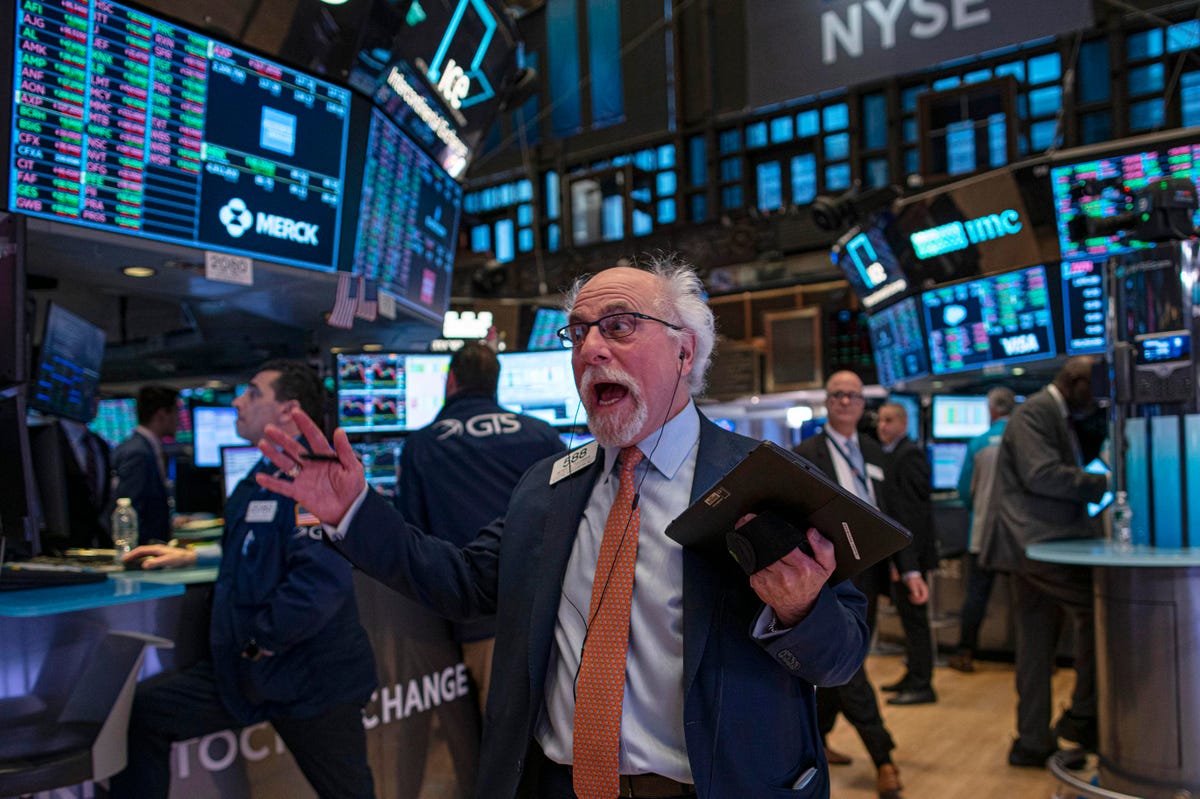
A trader reacts as he works on the floor of the New York Stock Exchange. (Photo by Kena … [+]
The S&P 500 Index turned in another very strong year, increasing 26.9% when stock market forecasters had expected a more muted gain of 7.7%. While it is impossible for them to be exactly right, keep in mind this saying, “Those who live by the crystal ball wind up eating glass” when looking at the results they have not been too far off the mark over the past 12 years.
Over that timeframe the analysts projections have been evenly split between being too rosy or pessimistic. In six of them they have overestimated how well the S&P 500 would perform for the year and in the other six they underestimated it.
However, in all of them the analysts started the year projecting the market to finish higher with increases ranging from 6.6% in 2020 to 24.4% in 2019 (when it finished 28.9% higher). There have only been three years when the S&P 500 has finished lower; down by 4 cents in 2011; 0.7% in 2015 and 6.2% in 2018.
The worst year that the analyst overestimated how the Index would perform was 2018 when it was 13% short of their target. The target was 2,883 but it closed at 2,507. This was coming off a better than average year gain of 19.4% in 2017 and expectations probably got ahead of themselves due to the corporate tax cut just being signed.
The second worst year that the analysts overestimated how the Index would perform was 2011 when there was an 11.1% shortfall. Their average target, per John Butters at FactSet, was for the S&P 500 to close at 1,415 but it ended at 1,258.
MORE FOR YOU
The worst year that the analysts underestimated how the Index would perform was this year’s gain of 26.9% when it closed at 4,766 vs. their beginning of the year estimate of 4,044 (note that this would have been a gain of 7.7%). The analysts were off by 17.8 percentage points.
The second worst underestimation of 13.3% occurred in 2013 when the analysts projected a close of 1,632 vs. the actual of 1,848. Again note that a close of 1,632 would have resulted in a gain of 14.4% vs. the actual gain of 29.6%.
S&P 500 Targets vs. Actuals
One reason analysts tend to underestimate how the market will do is that they would prefer to under-promise and over-deliver. Investors tend to feel better when markets are stronger than expected and who wouldn’t want to have happy clients. Another reason is that analysts prefer to raise forecasts during the year vs. cutting them.
For the past three years the analyst’s consensus target has been short of the actual year-end outcome, with differences ranging from 3.6% in 2019 to 17.8% this year.
- 2010: Target
TGT 1,275; Actual 1,258; short by 1.4% of target - 2011: Target 1,415; Actual 1,258; short by 11.1%
- 2012: Target 1,475; Actual 1,426; short by 3.3%
- 2013: Target 1,632; Actual 1,848; outperform by 13.3%
- 2014: Target 1,974; Actual 2,059; outperform by 4.3%
- 2015: Target 2,236; Actual 2,044; short by 8.6%
- 2016: Target 2,343; Actual 2,239; short by 4.4%
- 2017: Target 2,461; Actual 2,674; outperform by 8.6%
- 2018: Target 2,283; Actual 2,507; short by 13.0%
- 2019: Target 3,118; Actual 3,231; outperform by 3.6%
- 2020: Target 3,443; Actual 3,756; outperform by 9.1%
- 2021: Target 4,044; Actual 4,766; outperform by 17.8%
- 2022: Target 5,225
S&P 500 has been helped by rising P/E multiples
While stock markets have seen a few significant downturns over the past decade, one of the key valuation metrics or the Price to Earnings multiple has essentially seen an increase on how much investors are willing to pay for earnings. One of the key questions is will investors still be willing to pay an above average multiple as the Fed starts to tighten.
S&P 500 forward P/E multiple
Earnings growth will slow
While S&P 500 earnings growth rate will almost certainly slow in 2022 from 2021’s 46%, it is forecast to increase 8.7% and to be 37% higher than pre-pandemic 2019’s. If P/E multiples could stay the same in 2022 the market increasing 9% would be considered very solid, especially after such a strong three-year performance.
However, probably the biggest risk to the market’s equation of earnings times the P/E ratio is the current 21x multiple falling.
S&P 500 earnings
2022 outlook
One way to provide a range for the 2022’s year-end value is to bracket the analyst’s estimate with the worst shortfall of 13% and the worst underestimations of 13.3% and 17.8%. While I’m including this year’s 17.8% outperformance, due to what is hopefully one-time events of Covid-19 and the vaccine rollout, I believe it is better to use 2013’s 13.3%. These are the ending values for the S&P 500 based on the three scenarios and the Index’s loss or gain.
- Low-end: 4,544 which would be 4.7% below today’s close
- High-end (13.3%): 5,918, up 24.2%
- High-end (17.8%): 6,157, up 29.2%
Tom Lee at Fundstrat has a 2022 year-end target of 5,100
Tom Lee is one of the more visible and I believe accurate market forecaster. He pretty much remained bullish the past 18 months, as the markets have had to navigate Covid-19.
His 5,100 target is based on 2023 earnings of $250 for the S&P 500 companies times a P/E multiple of 20.5x. He points out on the chart below that the largest downdraft for the S&P 500 was 5% in 2021 and that the markets could be down as much as 10% during 2022. However, it winds up the year with a 6.3% increase.
2022 S&P 500 forecast




